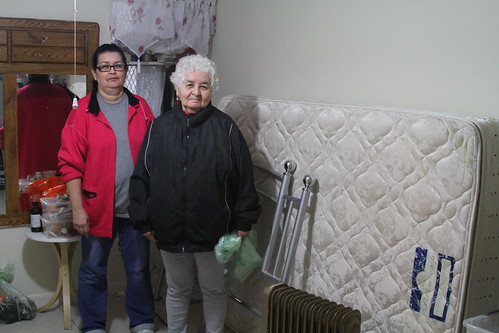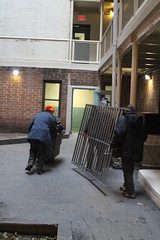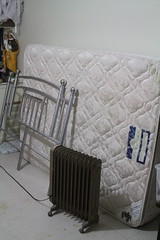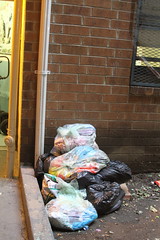Ursula Ramos spent more than a decade asking the New York City Housing Authority for a transfer from her dark basement apartment on East Tenth Street. Earlier this month she finally got it, after Sandy flooded the unit with roughly three feet of water and destroyed nearly all of her possessions.
For twenty-two years, Ms. Ramos, 78, and her adult son shared a two-room basement unit at 384 East Tenth Street, in the Lower East Side Apartments. She spent eleven of those years asking for a transfer to another Section Eight apartment, but was told each time nothing was available.
“This isn’t an apartment, this is like a basement,” said Aurora Rodriguez, Ms. Ramos’ daughter while standing in the apartment in the days after Sandy hit. “But they make it an apartment.”
According to building records, the unit is listed as on the basement level, and shares the floor with the building’s laundry and trash compactor rooms. Its ceilings are considerably lower than in other units, and its windows, located halfway below sidewalk level, allow in little natural light. Ms. Ramos has diabetes and heart problems, and believed the lack of light and ventilation to be bad for her already poor health. The unit had long been plagued by plumbing problems, she and her daughter said, with water coming up from the toilet and bathtub in the past. Ms. Rodriguez said such issues occurred as a result of the sewers overflowing during heavy rains.
But those aggravations paled in comparison to what happened on Oct. 29.
Ms. Rodriguez often called her mother to inform her about the weather: little could be observed from the apartment in which the kitchen window provided an eye-level view of the Tenth Street sidewalk. After hearing shouts and watching people running past the window of her own Ninth Street Apartment as the East River overtook Avenue C, Ms. Rodriguez rang to tell her mother, “La agua esta a tu puerta!” – “the water is at your door!”
“She wasn’t believing me!” she said of her mother, shaking her head.
On Friday and Saturday after the storm, the Local accompanied Ms. Ramos and Ms. Rodriguez as they surveyed the damage. A sofa, chests, electronics and cabinets were destroyed. A mattress, soaked halfway through, stood on its side, drying out next to a space heater (it eventually joined the box spring in the trash). Closet doors couldn’t be opened fully because the floors were now warped and uneven. Nearly all of Ms. Ramos’ soaked clothes were in garbage bags.
On Nov. 5, Ms. Ramos was transferred to a new apartment two blocks up from her flooded unit. This one is bigger, and has two bedrooms, to better accommodate Ms. Ramos and her son, who had slept in the previous apartment’s common room. Three windows offer a view onto a courtyard, allowing Ms. Ramos a better view of the world – and the weather – outside her door.
According to Ms. Rodriguez, the old apartment is currently being renovated and it’s uncertain whether her mother will be asked to move back into it. She said the manager seemed to indicate that her mother could stay in the new unit, but that there was still a possibility that she might be asked to move back and she didn’t yet know what would happen. CDC Management, which oversees the Lower East Side Apartments, did not return calls requesting comment. A New York City Housing Authority spokesperson said that tenants who were displaced by the storm would be permitted to stay in their new residences, if they so desired.
Ms. Ramos — currently sleeping on a sofabed left behind by previous tenants – is still struggling with the transition to the new apartment and the loss of nearly all of her possessions. She said she is recovering “poco a poco” – little by little – and knows that many others suffered far greater losses.
For her part, Ms. Rodriguez said she and her siblings would fight to make sure their mother wasn’t transferred back to her old unit.
“I told her, the sewer is coming up again. It’s not good for her,” said Ms. Rodriguez. “It’s going to happen again, again, again.”








